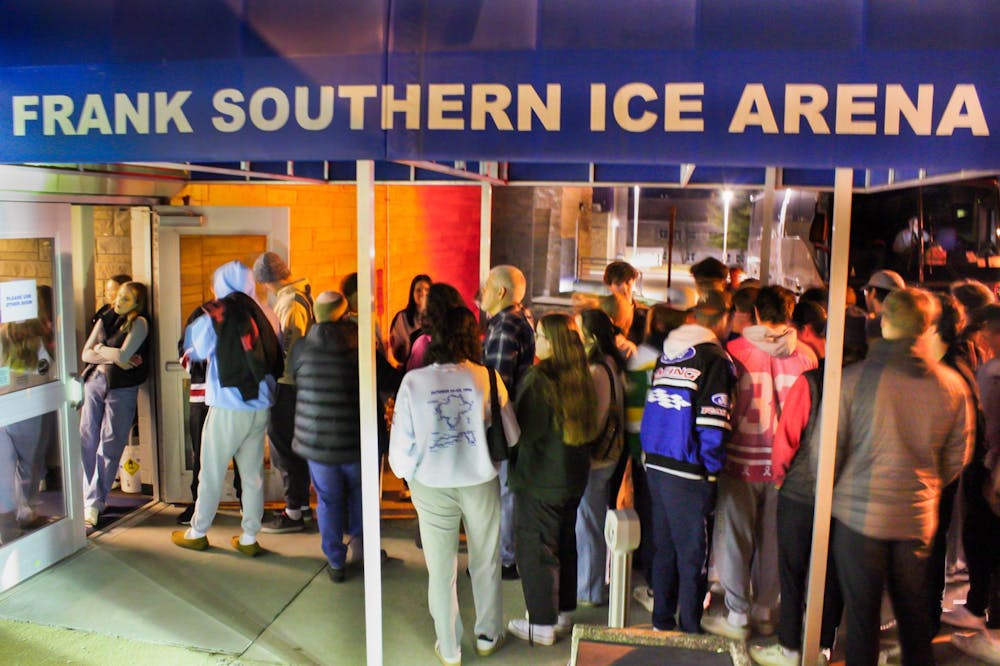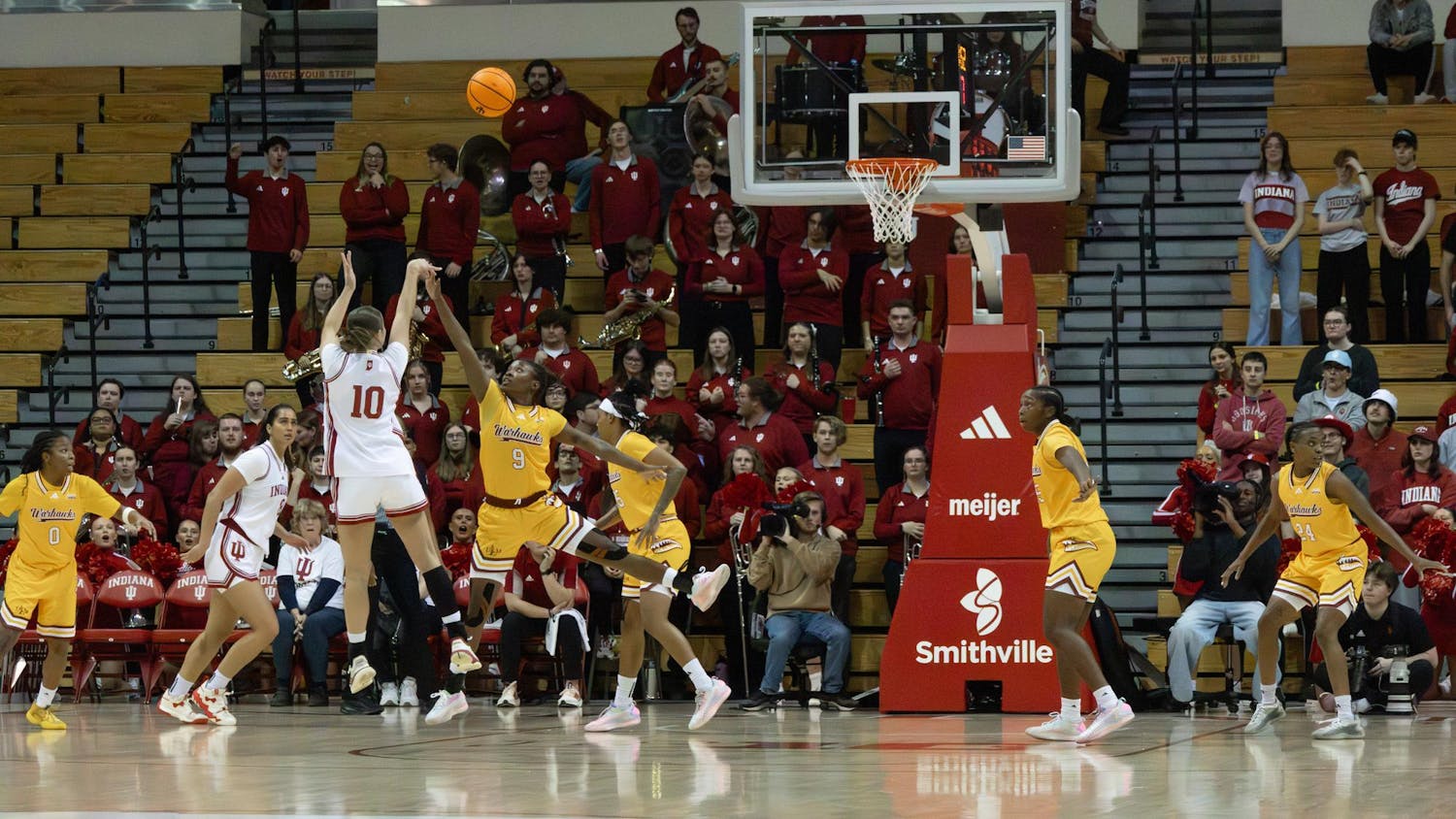Walking into Frank Southern Ice Arena in the early morning, it’s not obvious the rink is home to eight youth hockey teams, three collegiate hockey clubs, a beer league and two figure skating clubs.
The whiteboard hanging from the rafters in the lobby gives some of it away with a color-coded rink schedule. Take a couple steps further on sticky rubber floors — designed to protect the blades of rink goers — and the smell of something freezer burnt fills the air.
The rink is only open five months out of the year. It’s small. The seating is subpar. The lobby is retro. But that’s not how Indiana club hockey sees it. What the team feels for Frank Southern is different. There’s history here, 57 years of it.
At IU, hockey is a club sport. This year, the Division II team is a 31-man machine, tearing through its schedule. At the end of the regular season, the club’s record is 25-6 and they rank third in the region.

Despite the club’s strength, Indiana is one of seven Big Ten schools without a hockey team in the conference. Wisconsin, Michigan State, the University of Notre Dame, Michigan, Penn State and Minnesota all have their own rinks and compete at the NCAA level.
Instead of playing in the NCAA, Indiana hockey belongs to the American College Hockey Association. Within ACHA, there are three divisions. IU has an ACHA Division II team and a Division III team but no Division I team.
To be an ACHA Division I team or a Big Ten team, IU needs its own rink, and while Frank Southern Ice Arena is nostalgic, it isn’t up to standard. The ACHA requires a Division I rink to seat at least 500 people. Frank Southern Ice Arena seats around 200.
Junior Drew Micheli is the president of the Division II hockey club at IU. He said the club tries to act like a Division I club as much as possible outside of having the actual designation. Despite the lack of seating at Frank Southern, Micheli says the club brings in an average of 400-500 people each home game.
“That’s pretty much what’s holding us back, support from the school and a bigger place to play,” Micheli said. “If we had a facility that sat even like 3,000 or 3,500, I think we would almost sell out every game.”
The rink, nicknamed “the Frank,” was built in 1967. It was completely outdoors until it was enclosed in 1988.
By 1998, the facility was worn down. The rink — which is subsidized by the City of Bloomington — was losing money, set to close in March 2000.
A few Bloomington residents came together around that time and formed the Ice Rink Task Force. Not only did they want to keep Frank Southern open, but they wanted to build a new rink, too.
Private developers weren’t interested in funding a new rink and neither was IU Athletics, a representative said. The task force compromised to focus on giving Frank Southern $300,000 worth of renovations.
The task force secured $150,000 from the City of Bloomington, $100,000 from a Build Indiana grant and $50,000 from the Lilly Foundation. The rink was dehumidified, painted and outfitted with a party room.
Historically, the Bloomington community has put in effort to make ice sports a possibility in the city. But with no progress since 2000, some think it is time to take the next step.
Madeleine Thompson is the secretary of Women’s Hockey at IU, a club sport that accepts members of all skill levels.
“There is a lot of demand and evidence to justify a university rink,” Thompson said. “So, I would want to ask, why not now?”
As it stands, the number of organizations that require ice time presents a problem. The rink is subsidized by the City of Bloomington, and the Parks and Recreation Department runs the house hockey youth team.
Because of this, the Frank Southern staff is faced with dividing ice time between IU clubs, other organizations and its own projects.
A representative from Frank Southern Ice Arena said the youth program and house hockey programs receive priority when booking ice time.
Though the two organizations are often at odds with each other when reserving ice, Indiana club hockey wants to build a relationship with the Bloomington youth teams.
“We’ve been helping out the youth program as much as we can, and we have a few guys that are going to be helping them at practices this year,” Micheli said.
When Frank Southern ice time is unavailable — at the beginning of the season when the rink is still closed, for example — the club is forced to drive to other cities to practice.

Tryouts take place in early August. Frank Southern doesn’t open until October, so both the Division II and Division III clubs held tryouts at Hamilton Ice Arena in Columbus, Indiana, this season.
Junior Andrew Gelman is the president of the Division III hockey club. He said renting ice time at Hamilton Ice Arena during Frank Southern’s off season is expensive. The hourly rate is $40 higher than in Bloomington.
During the regular season, when Frank Southern has no times available for a game, Micheli takes his team to Perry Park on the south side of Indianapolis, where ice time is cheaper. Gelman said he was thinking about holding tryouts there next year.
Even with these other options, Division II is occasionally forced to compromise and play late-night games at Frank Southern. On Oct. 27, the team played against the University of Kentucky. Puck drop was at 11:45 p.m., and the game lasted over two hours.
Not only is booking ice time difficult for the clubs, but it also costs them $240 an hour. Division III is only registered as a student organization, which means the members pay the entire cost. The Division II club is allocated some money by the Club Sports Federation, as it is registered with IU as a club sport.
“It’s just enough to cover our practice ice bills for the year,” Micheli said. “Everything else is out of our own pockets and the money we raise from merchandise and games.”
The Division II club makes money off of its home games through ticket sales.

Both clubs practice twice a week and hold home games frequently with travel being the biggest expense for each team. Micheli didn’t disclose member dues, but Gelman said the average cost for his members this semester was $2,200 each.
An IU Athletics representative said there are many reasons why IU does not have an on-campus rink, including funding, space and Title IX concerns. But club leaders think the school would benefit from a new facility.
“I think Division I college hockey and the NCAA right now are the fastest growing sports in college,” Micheli said. “I think IU absolutely has the potential to do it.”
The U.S. has seen an uptick in the popularity of hockey over recent years, which could suggest a growing market.
“I mean, you’re in the Midwest, not far from Chicago, where everyone’s a Blackhawks fan,” Gelman said. “People come from the Northeast, where hockey is huge. Look at other Big Ten Schools.”
Not only are students interested in watching hockey, but they are interested in playing the sport, too, Thompson said.
“Within the past year, we have seen a lot of growth in the team,” Thompson said. “A lot more individuals are coming to us having played or skated before, which I think shows you the growing interest and need for a facility.”
In the meantime, the hockey clubs aren’t discouraged. Micheli said even if other schools look down on Frank Southern, the place is still special to them.
“Well, they probably don’t think it’s the greatest, but we use it as an advantage,” Micheli said. “We work on it in practice. We’re skating on a smaller rink. It’s a lot harder for teams to come in and adjust to that.”
Micheli, Gelman and Thompson will continue to run their teams as normal, regardless of where they skate. What happens on the ice is what matters to them most.
“When I see others light up when they hit the ice, it’s just like how I feel every single time I lace up my skates,” Thompson said. “There is nothing like it.”




